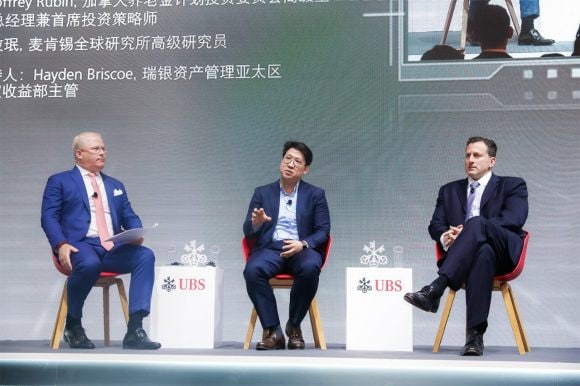China's place in the world
China's economy and financial markets. How big are they, how do they impact the world and what trends should investors follow?

Moderator:
- Hayden Briscoe, Head of Fixed Income, Asia Pacific, UBS Asset Management
Panelists:
- Geoffrey Rubin, Senior Managing Director and Chief Investment Strategist, Canada Public Pension Investment Board (CPPIB)
- Jeongmin Seong, Partner, McKinsey Global Institute
Key takeaways:
Key takeaways:
- China lies at the heart of the Asian economic bloc and drives the global economy;
- China's influence has grown but its economy is becoming more Chinese, i.e. driven by domestic demand;
- Urbanization and growth in services still have a lot more room to both grow and propel the economy in the coming years;
- China deserves and merits a strong place in investors' portfolios because of macro growth prospects, the size of investible opportunities, diversification benefits, and the strength of the rule of law;
- Trade tensions have not fundamentally altered China's long-term growth prospects.
China's place in the world: if the world is a solar system, then China is at the heart of it – that was Hayden Briscoe's key message in a dedicated session looking at China's place in the world and its importance to investors.
China is one part of the world’s largest economic bloc
China is one part of the world’s largest economic bloc
Expanding on the theme, Jeongmin Seong positioned China as one of four key areas in the Asian economic bloc, complemented by Advanced Asia (South Korea, Japan, Singapore), Emerging Asia (including Vietnam), and Frontier Asia (including India).
While the four areas appear distinct, Seong remarked that these different parts of Asia have become increasingly inter-linked as trade, capital, and labor flows drive a process of regionalization in Asia.
Seong went on to explain that this process of regionalization in Asia is one aspect of an ongoing Asian growth story. Seong remarked that 'Asia is already the world's largest economic bloc and is forecast to account for more than half of total global GDP by 2040.'
'Asia is already the world's largest economic bloc and is forecast to account for more than half of total global GDP by 2040.'
China is an anchor for Asia
China is an anchor for Asia
Looking more specifically at China’s role within Asia, Seong explained how China has become the regional anchor for the Asian economic bloc.
In part, that is because it is deeply embedded in regional supply chains as both a source of inputs and a market for finished products.
Expanding on China's role as an anchor, Seong explained that China is increasingly influential as a source of capital and knowledge for Asia.
China provides a significant amount of funding for innovative start-ups in the region and is also a rich source of ideas and new business models, in areas like fintech, cashless payments, and mobility.
China is becoming more Chinese
China is becoming more Chinese
Importantly, China's strong influence on the world and regional economy in Asia is not the same as China's exposure to trends within the world economy.
Seong remarked that China's economy is - in fact - becoming less exposed to the rest of the world on a relative basis.
Specifically, in Seong's view, 'China is becoming more Chinese, with its own growth increasingly driven by domestic sources, like consumer demand, rather than exports.'
That's why China's economy has continued to grow, despite US pressure on the trade front, because consumer demand has remained robust.
And the drivers behind China's domestic demand story still have much more room to grow.
Seong cited urbanization as a key driver. Seong estimated that China’s urbanization rate is currently around 60%, and has room to catch up with the rates of 80% by 2050 seen in the developed world.

Find out about the four domestic forces driving China.
If urbanization in China increases, Seong believes it can be a tailwind for the economy because it can move rural residents into better-paying urban jobs and drive investment in the economy through channels like infrastructure and housing development.
The second key and related growth is the services sector.
China’s services sector, though growing fast, lags behind more developed nations in terms of its contribution to overall GDP growth.
For Seong, that’s because many aspects of the services economy are influenced by the state-owned sector and also restricted from foreign investment.
With further reforms – such as recent moves to open financial services to foreign investors – Seong believes that the services sector can be a key source of growth in the future, and offer many opportunities to investors.

China’s Globalization 2.0
China’s Globalization 2.0
But China has great potential to grow through further opening up.
In fact, Seong believes China’s next phase of globalization is just getting started.
Naming China’s initial opening up from 1978 as ‘Globalization 1.0,’ Seong believes there are signs that China is embarking on a process he calls ‘Globalization 2.0’ – a process through which China pushes for more integration with the global economy.
For Seong, China's moves to open its financial markets are part of this process. China's equity and bond markets are already large, but foreign participation is low. Moves like the Stock & Bond Connects have opened up onshore markets to investors and there is much more room to grow.
Speaking more widely, further integration into the global economy could generate significant growth in areas like financial services, data flows and cultural exports.
In the case of the latter, Seong argued that China has one of the world’s largest film industries but still doesn’t export that expertise, and that’s an area where greater integration with the world could support future growth.
Learn more about Stock Connect in our one minute video
China deserves and merits a strong place in portfolio allocations
China deserves and merits a strong place in portfolio allocations
Adding an expert investor's view to the high-level macro trends discussed, Geoffrey Rubin of Canada Public Pension Investment Board (CPPIB) explained why he believes China deserves and merits a strong place in portfolio allocations.
Geoffrey laid out a four- factor framework for country selection and portfolio construction including growth prospects at the macro level, the investible size of market opportunities, diversification benefits, and the strength of the rule of law.
In Rubin's view, China scores highly on the main criteria.
He said that 'domestic consumption is one of the major long-term investment themes in China that CPPIB looks to invest in through both public and private markets.'
In terms of allocation, Geoffrey said that over the next five years his firm will look to grow exposure to China in terms of the percentage share of the portfolio and in terms of absolute size.
Rubin stressed the diversification benefits of China exposure, particularly in terms of the trends of regionalization in Asia earlier discussed and political fragmentation seen recently in the world economy.
Looking more specifically at the issue of trade tensions, Rubin closed the session by saying that recent trade tensions are unlikely to fundamentally alter China's long-term growth prospects or CPPIB’s appetite for expanding their exposure to China.

Learn how China's consumer demand is driving the world economy here:
Closing remarks
Closing remarks
Wrapping up the session, Briscoe reflected on how the discussion had taken in the various nuances of China’s size, influence and future prospects.
For Briscoe, the discussion illuminated just how China's rise has opened up opportunities for investors to participate in key themes like the opening of financial markets, the growth of the Chinese consumer, and the expansion of the services sector.
Beyond such thematic trends, Briscoe also stressed how trends like regionalization and potential political dislocation offer valuable diversification benefits for investors that can be built into global portfolios.
So there is much for investors to consider in 2020 as China's influence grows, particularly because this process is creating a range of increasingly compelling investment opportunities that have the potential to benefit investors over the long term.
